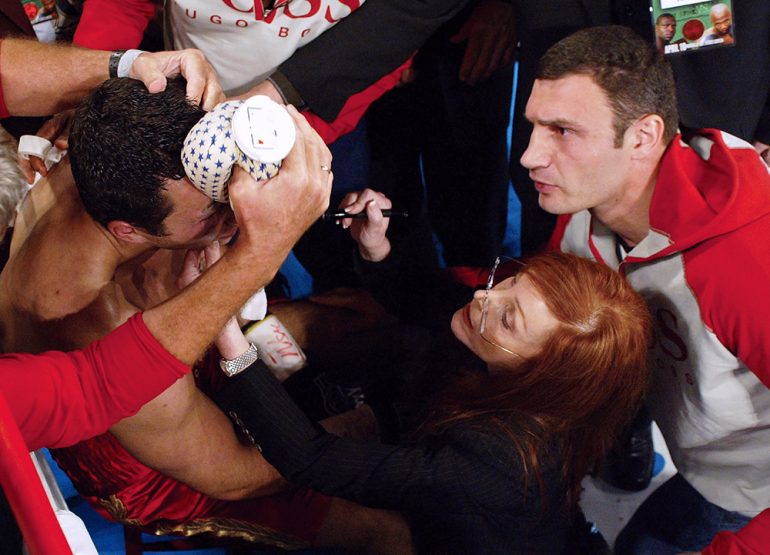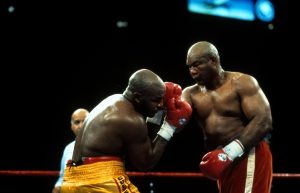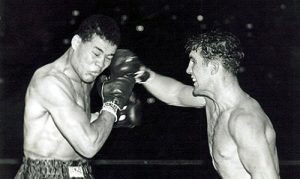Dougie’s Monday mailbag

STOPPING ONE-SIDED FIGHTS
Hi Dougie,
In today’s mailbag you wrote: “Fights need to be stopped once they aren’t competitive.”
Surely under that rule Foreman’s fight with Moorer would have been stopped long before Forman turned things round with one of the most dramatic knockouts in history? – Dave Rado, Colchester, UK
True. So, allow me to amend that statement with an important detail (that I thought went without saying): Fights need to be stopped once they become one-sided BEATINGS.

Foreman (right) lands the knockout shot on Moorer. Photo by THE RING Archive
Foreman was losing – badly – but even at 45, he was a big, strong, sturdy, powerful son of gun, who was able to stand his ground against the younger (but smaller, by almost 30 pounds) man. Beyond his punch resistance, Big George was able to land solid shots here and there during the 1994 bout, even walking Moorer down in spots during the late rounds. During the first minute of Round 8, two rounds before the “miracle KO,” Foreman visibly stunned Moorer into the ropes with a pair of straight right hands. Now, the reigning heavyweight champ came back and put heavy hands on Foreman for the remainder of the round, but although the old man lost another round, he demonstrated that he could land punches and HURT his antagonist. And even though his punch output was low, and he was extremely susceptible to Moorer jolting southpaw jab, Foreman worked his own jab fairly well throughout the fight and had the wherewithal to block and parry punches with his gloves and arms.
A CULTURE SHIFT IS NEEDED IN BOXING
Doug,
I love what you’re doing with The Ring Magazine. Keep up the good work.
The events of the past week or so, have me thinking. Here are those thoughts, with my question for you at the end.
Boxing has always been known as a warrior’s sport. Boxers aren’t merely athletes; they’re fighters.
The culture of professional boxing dictates that fighters do whatever they can, not merely to beat their opponents, but to pulverize them. Scoring favors power, aggression, and “fan friendliness” (read: blood and guts). And if a fighter finds himself in a contest he’s clearly unlikely to win, then a public premium is paid for that fighter going the distance, or going out on his shield.
In the 40s through the 70s, it wasn’t uncommon to see world class fighters sporting records that included losses in the double digits. But somewhere in the mid to late 80s, promotional considerations (read: money) saw matchmakers doing their level best to produce fighters with glossy undefeated records. Through the 90s and into the 2000s, it became increasingly the case that the momentum of an up and comer’s career could be seriously diminished if he suffered even a single defeat. Unless the fighter already had a “big name,” two or three losses could completely derail a fighter’s campaign for fame and fortune. So, these days, it isn’t unusual to see fighters with 20 or even 30 wins against zero losses, and holding “championship belts,” who remain relatively untested in the ring.
The upshot of this is that the stigma of losing is so thick, that fighters, corners, and even referees let fights go on long after they’ve ceased to be competitive. And while in a sport like, say, baseball, it might be embarrassing to be completely outclassed, in boxing it can be deadly. Frankly, fighters can and have died from injuries sustained in the ring. Sadly, we’ve seen this occur this very month, July 2019.
While MMA, mixed martial arts, contests, like those conducted in the UFC, have a reputation for being particularly brutal, owing in large part to fighters being permitted under the rules to strike a fallen opponent, the truth is, by and large, MMA is much safer today than boxing. In boxing, while a downed fighter might be afforded shelter from more immediate punishment from his opponent, he is also given just enough time to recover (a 10 count) to get back into the fray and absorb more punches. In MMA, a downed fighter is almost always declared knocked out immediately. So, we find MMA fighters with 7, 8, 9 or more losses competing at the world class level, because everyone understands that losses are just part of the safety regulations of the sport. Fights are often stopped earlier than they could be, and everyone accepts what this means for fighter records, because the health of the fighter comes first. In boxing, on the other hand, a downed fighter can keep getting up and “competing,” often several times. And, where this sometimes does produce memorable moments where the hurt fighter manages to come back for the victory, more often it just prolongs the inevitable.
The culture of boxing, particularly a combination of 1.) an expectation of fighters being willing to “die in the ring,” and 2.) a premium being placed on unrealistic and inflated undefeated records, has led to predictable results: more catastrophic injuries, and yes, deaths.
It’s time for this to stop. Boxing needs to reinvent itself for the 21st century. Perhaps fights need to be scheduled for fewer rounds. But certainly they need to be stopped sooner when they’ve ceased to be competitive.
I know that this will require a culture shift. And some of that will be difficult. It will take a while for fighters and fans alike to realize that a loss doesn’t end a career. Fights will end sooner, and fans won’t be “treated” to as many definitive outcomes where one fighter is beaten within an inch of his life. Tough. No one should have to die for a sport. The fans will just have to get over it.
But it won’t be all bad. If fights are stopped sooner, and losses are accepted as a regular part of the sport, we’ll see more fighters and promoters willing to make matches with tough opponents. Contests won’t be as grueling, and therefore fighters will get in the ring more often than the now standard 2 times a year for major headliners. Genuine tournaments might make a comeback where true champions are crowned. But above all, we might get to a point where no one dies from injuries sustained in the ring anymore. *That, to me, is worth the changes.
What do you think, Doug? – Dan
I don’t think there will ever be a point where no one dies or sustains serious brain injuries in boxing, but I do think it’s possible for the sport to do a better job of protecting the fighters and I also think the majority of boxing’s fandom can get over the undefeated-record fetish as we move into the 2020s.
While I don’t believe that every TV main event needs to be scheduled for 10 or 12 rounds, I’m not in favor of reducing the rounds for major title bouts. However, as I stated in Friday’s mailbag, I think fights need to be stopped sooner when they become brutally one-sided. Just because a fighter can take a beating doesn’t mean he or she should. It’s OK to lose rounds and lose bouts, but you gotta be able to protect yourself and fire back in there.
Boxing has always been known as a warrior’s sport. Boxers aren’t merely athletes; they’re fighters. And that’s OK. It’s only natural that someone brave and proud enough to step inside those ropes is going to be a natural-born fighter. I say let them be warriors if that’s who they are. It’s the job of the trainers, managers, promoters, matchmakers, the commission and its officials to safeguard the warriors. Trainers and managers need to know their fighters’ limits. Promoters and matchmakers need to be careful about making mismatches or overmatching up-and-comers. Referees and ringside doctors need to call a fight off regardless of what the beaten fighter or corner or fans might say after it’s stopped. That’s their job. The boxer’s job is to fight his or her fight. If he or she is a blood-and-guts warrior, so be it.
The culture of professional boxing dictates that fighters do whatever they can, not merely to beat their opponents, but to pulverize them. Yeah, IF they can do that. Some can. Most can’t. Most successful boxers win by outboxing or outworking their opponents.
Scoring favors power, aggression, and “fan friendliness” (read: blood and guts). Most of the time, yeah. And I’m OK with that.
And if a fighter finds himself in a contest he’s clearly unlikely to win, then a public premium is paid for that fighter going the distance, or going out on his shield. I agree that respect to a fighter going the distance while taking a God-awful beating is something that’s got to change. That should never be a point of pride for any fighter or his team. I think this is changing. I’ve noticed more social media ridicule for corners that allow their fighters to remain in brutally one-sided fights. A lot of that public scorn should also go to the referees that allow beatdowns to continue. I’m OK with a fighter going out on his shield if the fight is an evenly matched shootout. If you get clipped in fire fight it’s just part of the sport in my opinion. However, if a boxer has had the s__t kicked out of him for several rounds and he’s got nothing left in the tank and just decides to flail his limp body at his punisher, who ices him, well DUH, that’s no f__king good. That we can all do without, but that goes back to the referee and the corner knowing when to stop a fight.
MANNY > FLOYD
Hey, Doug.
Long time reader here. Contemplating the all-time standing of Pac and May, respectively, the obvious occurred to me: that Pacquiao is not a natural welterweight. In fact, he has a caloric intake many times that of the average person, just to maintain himself at 147. This is a fighter whose optimum weight is likely 135. It is astonishing what Manny has accomplished having essentially blown up to welterweight. Not even accounting for the Thurman win, I rate Manny ahead of Floyd all time; the fact that he was even competitive with the so called ‘best’ of his generation is a testament to his greatness. As simple as this may sound, it seems to be a glaring oversight of most fight scribes and pundits. My best. – Danny
I don’t think fight scribes and pundits overlook that Pacquiao is not a natural welterweight. He burst into the consciousness of American fans and boxing media at junior featherweight and featherweight during the early 2000s. He evolved into a superstar during his rapid climb from junior lightweight to welterweight in 2008-2009.
We know he came up in weight from lighter divisions to compete at 147. So did many of his welterweight rivals. His four-bout series with Juan Manuel Marquez began at featherweight and ended at welterweight. Mayweather and Oscar De La Hoya came up from 130 pounds. Shane Mosley came up from 135 pounds. Miguel Cotto and Tim Bradley came up from 140 pounds.
Several welterweight champs that are enshrined in the International Boxing Hall of Fame began their careers at lighter weights, from Ray Robinson (135) to Kid Gavilan (122) to Jose Napoles (126).

Billy Conn began his pro career at 135 pounds but matured into a world class middleweight and light heavyweight who twice challenged Joe Louis for the heavyweight title.
Of course, Manny is special. He turned pro at 106 pounds and won his first world title at flyweight. But he turned pro at age 16. Looking at some other legendary fighters who began fighting at age 16 – the ultra-talented Tony Canzoneri and Billy Conn – I notice the same drastic climb in weight as their bodies matured. Canzoneri was world class from bantamweight to junior welterweight. Conn turned pro at 135 pounds, was considered a prospect at 147, entered The Ring’s rankings as a middleweight (where he defeated fellow hall of famers Fritzie Zivic, Teddy Yarosz and Young Corbett III), won the world title at light heavyweight (where he beat HOFers Tony Zale and Fred Apostoli), and challenged the great Joe Louis for the heavyweight title. Before you think to yourself “Yeah, but Manny won titles in eight weight classes, Dougie,” keep in mind that Canzoneri and Conn fought in an era of only eight weight classes, same-day weigh-ins and ONE world championship in each division.
My apologies for going off on the boxing history tangent. (It’s kinda my thing, tho.)
Anyway, I agree with your placement of Pacquiao ahead of his nemesis in the ATG rankings (if only slightly), but not because Manny began his career at a lighter weight. I give the senator the nod because he fought more badasses at their prime weight classes when they were still highly regarded and dangerous – primarily the nine-bout series against the great Mexican trio of Marco Antonio Barrera, Erik Morales and Juan Manuel Marquez from 2003 to 2012.
MAXIM DADASHEV
Hope all is well Doug,
As an avid boxing fan and a father of two; I would like to ask you if there’s a go fund me account for one of our fallen warriors in Maxim Dadashev. If this makes it to the mailbag I would like to implore our casual and as well as our hardcore fans to please donate at least $1 for the late 28 year old wife and son of Mr. Dadashev. – Miguel N.
Thanks for bringing this up, Miguel.
Please click on this link to visit the Maxim Dadashev Family Fund gofundme page: https://www.gofundme.com/f/madmaxdadashev
Email Fischer at [email protected]. Follow him on Twitter and IG at @dougiefischer, and watch him on Periscope every Sunday from SMC track.















